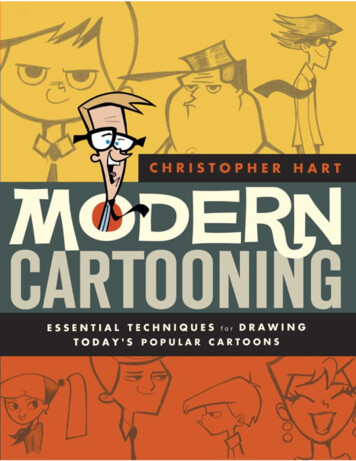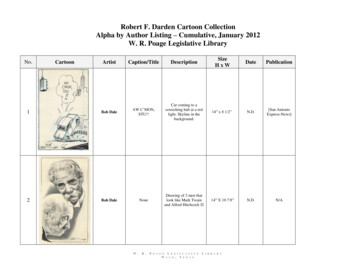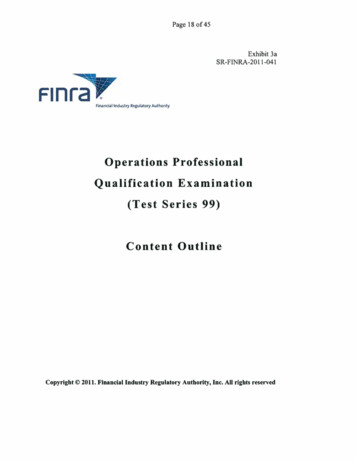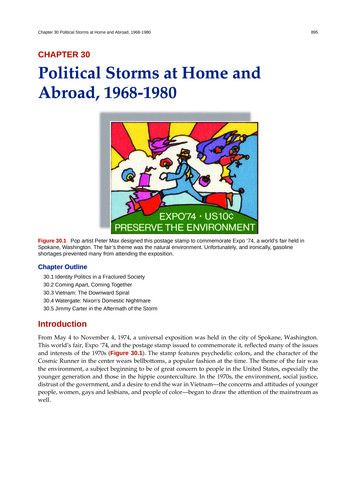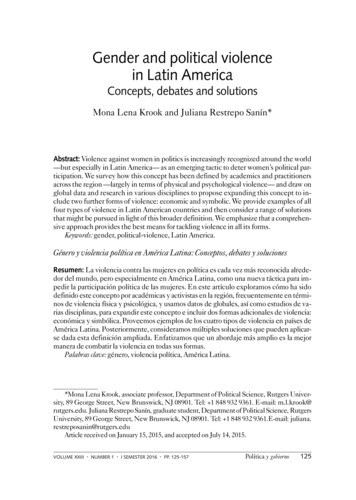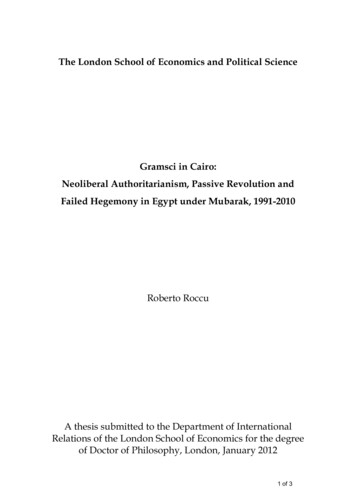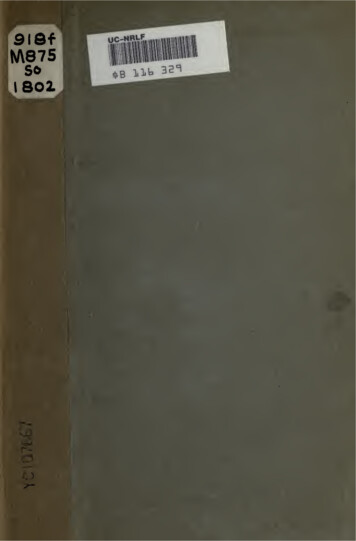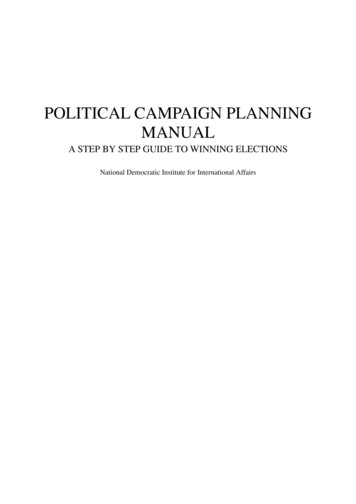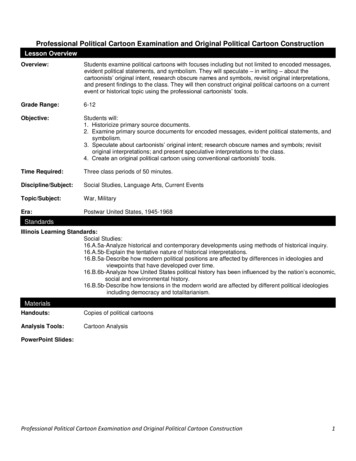
Transcription
Professional Political Cartoon Examination and Original Political Cartoon ConstructionLesson OverviewOverview:Students examine political cartoons with focuses including but not limited to encoded messages,evident political statements, and symbolism. They will speculate – in writing – about thecartoonists’ original intent, research obscure names and symbols, revisit original interpretations,and present findings to the class. They will then construct original political cartoons on a currentevent or historical topic using the professional cartoonists’ tools.Grade Range:6-12Objective:Students will:1. Historicize primary source documents.2. Examine primary source documents for encoded messages, evident political statements, andsymbolism.3. Speculate about cartoonists’ original intent; research obscure names and symbols; revisitoriginal interpretations; and present speculative interpretations to the class.4. Create an original political cartoon using conventional cartoonists’ tools.Time Required:Three class periods of 50 minutes.Discipline/Subject:Social Studies, Language Arts, Current EventsTopic/Subject:War, MilitaryEra:Postwar United States, 1945-1968StandardsIllinois Learning Standards:Social Studies:16.A.5a-Analyze historical and contemporary developments using methods of historical inquiry.16.A.5b-Explain the tentative nature of historical interpretations.16.B.5a-Describe how modern political positions are affected by differences in ideologies andviewpoints that have developed over time.16.B.6b-Analyze how United States political history has been influenced by the nation’s economic,social and environmental history.16.B.5b-Describe how tensions in the modern world are affected by different political ideologiesincluding democracy and totalitarianism.MaterialsHandouts:Copies of political cartoonsAnalysis Tools:Cartoon AnalysisPowerPoint Slides:Professional Political Cartoon Examination and Original Political Cartoon Construction1
But How to Let Go—GracefullyPublished in the Chicago American, 1965. Ink brush, crayon, and opaque white over graphite underdrawing nandCaricaturePrints and Photographs Division LC-DIG-ppmsca-09125 (13)1President Lyndon Johnson clings grimly to the tail of a giant tiger (labeled "Vietnam"), that lunges wildly through anocturnal universe in this cartoon by Vaughn Shoemaker (1902-1991). This drawing of 1965 addresses how Americawould extricate itself from the war in Vietnam. U.S. troops did pull out in 1973. A two-time Pulitzer Prize winner,Shoemaker studied at the Chicago Academy for Fine Arts, drew editorial cartoons at the Chicago Daily News fornearly thirty years, and taught at his alma mater. His artful, gestural style became looser and more painterly in a/images/ca013-09125v.jpg2Professional Political Cartoon Examination and Original Political Cartoon Construction2
The other ascent into the raphiteunderdrawingonlayeredpaperPublished in the Washington Post (61) LC-USZ62-127068During the presidential campaign of 1964, President Lyndon Johnson suggested that Republican candidate Barry3Goldwater could not to be trusted to keep the U.S. out of war. But not long after his election, Johnson increasedAmerican involvement in the Vietnam war and moved ultimately to take over the war itself. In the same week thatNASA sent the Gemini 4 space capsule into orbit, setting new records for a two-man flight, the State Departmentannounced that Johnson had authorized a potential role for direct American military involvement in Vietnam ifrequested by the South Vietnamese authorities. Herb Block was prescient in his view that this constituted a major stepin the involvement of U.S. forces in ck/images/s03463u.jpg4Professional Political Cartoon Examination and Original Political Cartoon Construction3
"Our position hasn't changed at all"June 17, 1965 Ink, graphite, and opaque white over graphite underdrawing on layered paperPublished in theWashington Post (62) LC-USZ62-127071After the State Department announced the possibility of a direct American combat role in Vietnam, the White House5issued "clarifications," insisting that there had been no change in policy. On June 16, 1965, the Defense Departmentannounced that 21,000 additional soldiers including 8,000 combat troops would go to Vietnam, bringing the total U.S.presence to more than 70,000 men. President Lyndon Johnson continued to obscure the extent of Americaninvolvement, contributing to a widespread perception of political untrustworthiness. The Gulf of Tonkin Resolution,based on a never-verified report of an attempted attack on an American ship, passed the Senate with only twodissenting votes, and gave Johnson all the authority he felt he needed to proceed with the ock/images/s03465u.jpg6Professional Political Cartoon Examination and Original Political Cartoon Construction4
"You see, the reason we're in Indochina is to protect us boys in Indochina"May 5, 1970 Ink, graphite, and opaque white over graphite underdrawing on layered paperPublished in the Washington Post (70) LC-USZ62-1269317Despite Richard Nixon's election campaign promises to end the Vietnam War, each new step widened rather thanreduced American lock/images/s03466u.jpg8Professional Political Cartoon Examination and Original Political Cartoon Construction5
Library of Congress Items:Title of Source:But How to Let Go--GracefullyCreator of Source:Shoemaker, VaughnDate of Creation:1965URL of /Title of Source:Creator of Source:Date of Creation:URL of Source:The other ascent into the unknownBlock, Herbert1965 June 10http://www.loc.gov/pictures/item/00652227/Title of Source:Creator of Source:Date of Creation:URL of Source:Our position hasn’t changed at allBlock, Herbert1965 June 17http://www.loc.gov/pictures/item/00652228/Title of Source:Creator of Source:Date of Creation:URL of Source:You see, the reason we’re in Indochina is to protect us boys in IndochinaBlock, Herbert1970 May resProcedure Step #Day One:1. The teacher will randomly divide primary sources among students and present powerpoint.Each individual student will get one political cartoon to historicize through observations andinferences. In doing so, the student will use “first glance” section of political cartoon analysis.2. The students as a large class will share their general observations and inferences. Theteacher will lead this discussion.3. The student will individually examine the primary source for encoded messages, evidentpolitical statements, and symbolism. The student will speculate about cartoonists’ originalintent. In doing so, they will use the “taking a closer look” section of the political cartoonanalysis.4. Students will organize into groups based on who has the same political cartoon. They willshare their individual interpretations, hear others’ interpretations, and brainstorm confusingnames, symbols and messages.Day Two:1. Students will individually research obscure names and symbols.2. Students will reorganize into groups based on political cartoons and revisit originalinterpretations. They will, as a group, fill out “cartoon purpose” section of political cartoonanalysis.3. Students, as a group, will present speculative interpretations to the class.Day Three:1. Students, individually, will create an original political cartoon using conventional cartoonists’tools and describe the tools employed to construct the cartoon.Resource or MaterialUsedLOC ItemsAnalysis ToolsPowerPointAnalysis ToolsAnalysis ToolEvaluationThe teacher will examine students’ original political cartoons and note the use of professional cartoonist’s tools. They willalso read the student’s reflective descriptions of the employed methods and see how accurate they were.ExtensionConsidering that this lesson is taught within a social studies education methods class context, I think the most logicalextension would be to teach youngsters in a similar way.Professional Political Cartoon Examination and Original Political Cartoon Construction6
Author Credits:J. BickfordEastern Illinois UniversityCollege of Education & Professional StudiesEarly Childhood, Elementary and Middle Level Education Dept.Professional Political Cartoon Examination and Original Political Cartoon Construction7
CARTOON ANALYSISFirst glance Look at the cartoon you were given or selected and list any of the following you rs:Sensory QualitiesAre lines bold, fussy, light, hard or soft?Taking a closer look ImagesWhich objects are used as symbols?Why were the symbols used and what do they represent?Is anything exaggerated? How?Is the cartoon realistic or abstract?List adjectives that describe emotions visible in the cartoon.WordsWhich words or phrases appear to be important? Why?Cartoon PurposeDescribe action taking place in the cartoon.Explain how the words in the cartoon explain the symbols.What is the message of the cartoon?Who are the people who might agree with the cartoon? What might be the public’s reaction to this cartoon?Professional Political Cartoon Examination and Original Political Cartoon Construction8
Professional Political Cartoon Examination and Original Political Cartoon Construction9
Professional Political Cartoon Examination and Original Political Cartoon Construction10
Professional Political Cartoon Examination and Original Political Cartoon Construction11
Professional Political Cartoon Examination and Original Political Cartoon Construction12
Professional Political Cartoon Examination and Original Political Cartoon Construction 2 1 But How to Let Go—Gracefully Published in the Chicago American, 1965. Ink brush, crayon, and opaque white over graphite underdrawing with overlays and paste-ons. Art Wood Collection of Cartoon and Caricature

